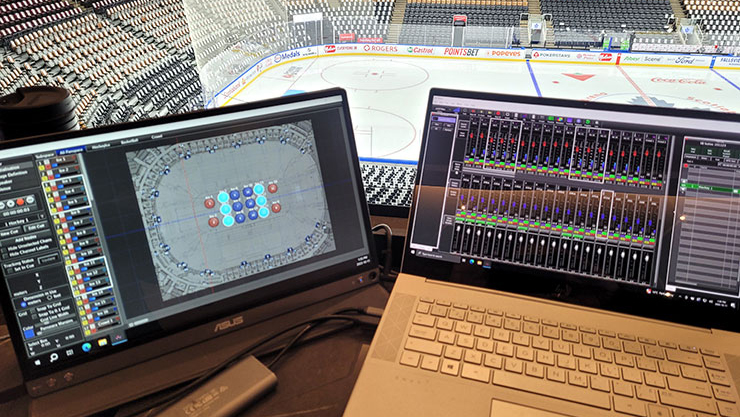Ontario’s Scotiabank Arena plays host to nearly 20,000 fans of the NHL’s Toronto Maple Leafs and NBA’s Toronto Raptors as well as serving as a space for an array of other live events. To ensure its fans have the most up-to-date technological experience, the arena underwent a recent refit and audio redesign of the original 68 open-fronted executive suites by creating 43 engaging multi-channel rooms driven by the powerful spatial audio capabilities of TiMax SoundHub.
The vision to bring directional sound from the court, ice and other high energy areas of the arena into the suites was fostered by MLSE’s Venue Technology leadership team, led by their head of sound, Courtney Ross. The project saw significant design and integration contributions from BranchAV’s Steve Svensson and WJHW’s Scott Bray. Fans in these suites, distributed around the full perimeter of the arena just above the 100-level seating, now benefit from an immersive audio sound field that delivers a similar level of excitement and connection with the action in the arena as enjoyed by those in the seats outside the suites.
The versatile TiMax SoundHub spatialization platform is configured to capture and reproduce an accurate and detailed encapsulation of a complete soundscape for each suite which matches its specific location and orientation relative to the playing surface; essentially delivering the ability to hear in context what is seen, not only in terms of left to right panorama but also near to far depth.
[Check Out the New LED Look for Penn State]
Recreating the multiple sound perspectives to be experienced by all the 43 suites, plus a large lounge area, presented a significant challenge which nevertheless was able to be solved with the powerful spatial audio capabilities of TiMax SoundHub. An initial fundamental TiMax spatial design concept was proposed by Dave Haydon of TiMax UK developers OutBoard, who subsequently visited the site during early commissioning to support integrator BranchAV’s specialist Steve Svensson with implementing and refining of the concept, based on his long-standing involvement and experience with Scotiabank Arena and its audio systems.
“The time it would take to manually program this in any other product would cost more than the price of the TiMax SoundHub and leave you with none of the operational features that have been optimized over the products 20-plus year development," Svensson commented. "It’s the only device on the planet that can accomplish the real technical requirement.”
Output from the strategically placed, digitally steerable microphone arrays are fed to TiMax where different spatialization configurations are rendered to create selective immersive setups to match hockey and basketball, which could then be quickly swapped to cater for changeovers between the varied event programming in Scotiabank Arena’s busy roster.
[NOW TRENDING: 4 Hot Topics in Pro AV]
Scotiabank Arena’s spatial rendering within the highly adaptable TiMax PanSpace workflow environment uniquely enables live audio captured from the multiple play zones to be recreated as an accurately localized soundscape within each suite, regardless of its position around the bowl perimeter. Additional effects sources are combined and/or discretely delivered to TiMax SoundHub via Dante, which then spatially matrixes them across strategic suite groupings with independent amplifiers.
Mounted 13 feet (4 meters) in front of each suite, just under the balcony overhang, is a single high-powered passive Renkus-Heinz dual 6-inch CX62 enclosure that provides a main center channel for the suite immersive system as well as delay reinforcement of the main bowl PA system’s audio playback content and announcements.
Left and right audio is delivered through a pair of compact coaxial speakers mounted just inside the front walls of each suite. A pair of ceiling speakers at the rear of each suite acts as a rear channel to complete the spatialization. To rationalize channel count and TiMax spatial rendering, adjacent suites in groups of three receive parallels of their location’s four TiMax stem feeds, which works due to their spatial and temporal relationships to the arena being closely matched.
To help further emulate the crowd immersion experienced outside the suite, various microphones located around the bowl pick up different crowd ambience zones, which are then selectively spatially aligned in the object-based TiMax Panspace to create a subtle immersive crowd sound field using all four speaker channels in each suite.
[Seattle Seahawks Ready for 2024 Season with New Technology Upgrade]
EQ tuning was fairly common to all suites due to their identical sound systems and similar dimensions, however the critical multiple spatial time-alignments specific to their varied locations were programmed quickly within the TiMax SoundHub Panspace object-based workflow. TiMax delay-matrix Image Definition objects were automatically and instantly calculated to feed all suites simultaneously, even including applying tactical negative delay offsets to compensate for the approximately 40-50ms sonic time-of-flight from the playing surface lobe zones to the mic arrays hanging in the central scoreboard.
“The absolute science behind what has been created here is a ‘first in the world’ innovative solution that to our knowledge no other sports venue in the world has matched,” concluded Bray. ”It has wowed everyone that’s experienced the suites since the season’s commenced, and it is now planned as a central facet of similar future WJHW arena projects.”
